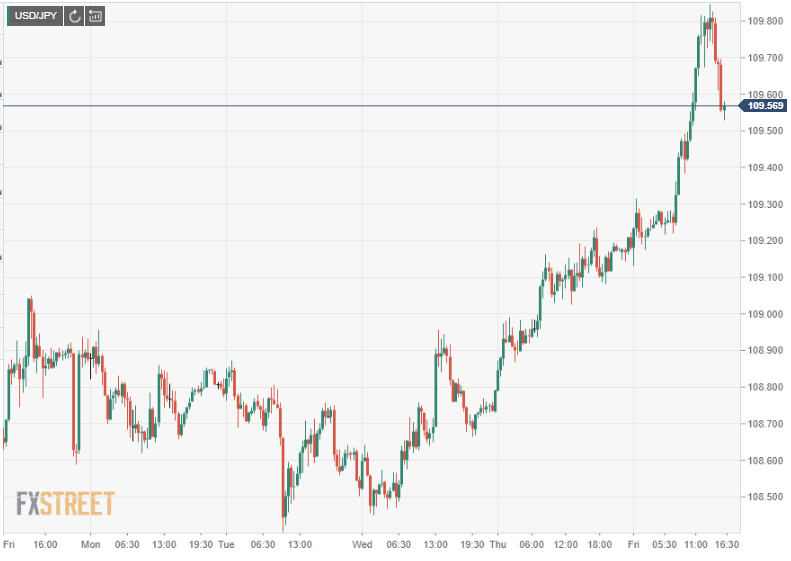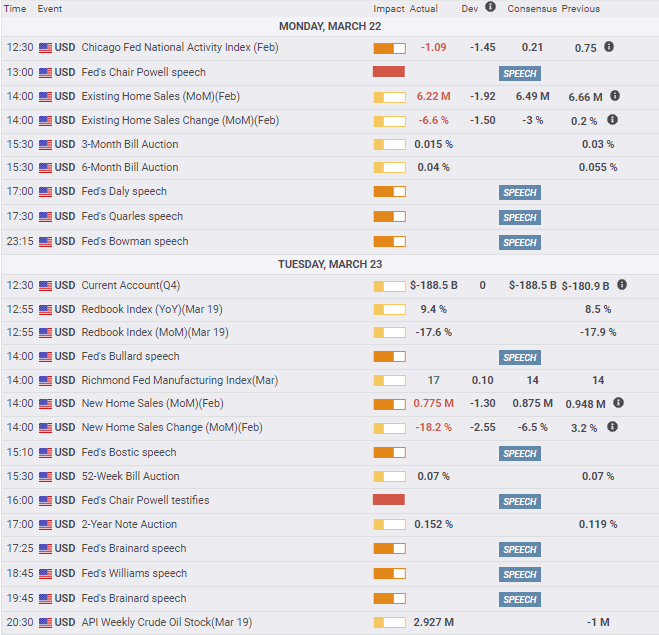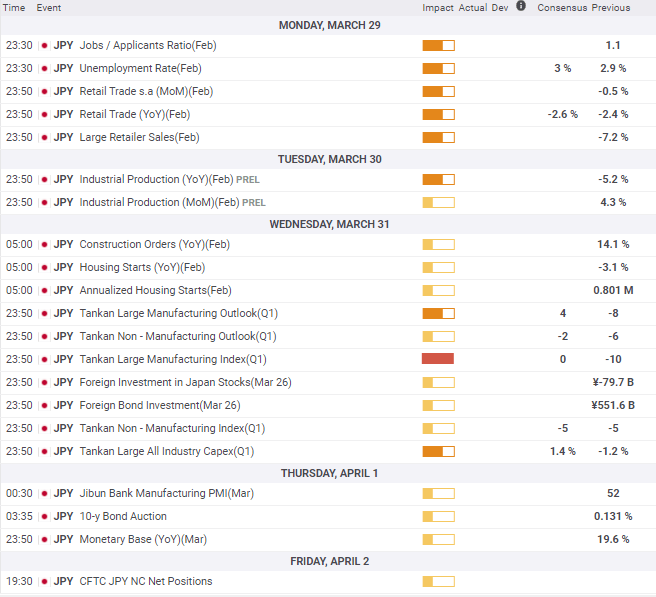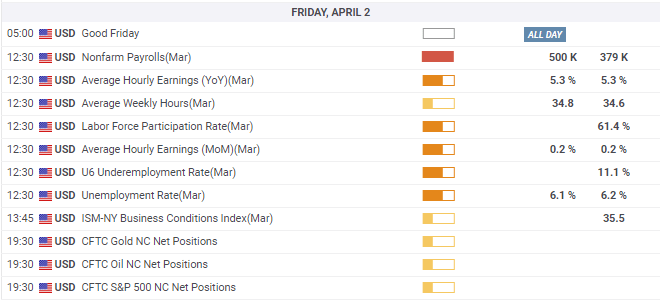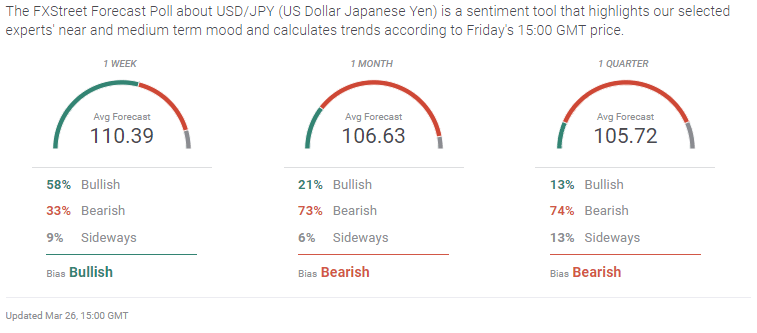- US Initial Jobless Claims and GDP data improve.
- 10-year Treasury rates dip on Thursday then recover.
- USD/JPY returns to 12-month high on Friday.
- FXStreet forecast Poll sees 110.00 in the immediate future
USD/JPY continued its consolidation in the early part of the week staying below 109.25 resistance, but Thursday's finish just below this level set the stage for an easy traverse on Friday and a straight run to the 12-month high.
American Treasury rates and improved US data were the main source of dollar strength.
The massive support the Bank of Japan (BOJ) is providing to equity prices may be having the opposite effect on perception, undermining what little confidence exists in the Japanese economy.
American Initial Jobless Claims, the telltale of the pandemic economy, fell to their lowest level since March 13, 2020, the last week before the lockdown explosion. Fourth quarter growth improved to 4.3% annualized in its final revision from the Bureau of Economic Analysis.
Federal Reserve Chair Jerome Powell threaded the needle in his CARES Act Congressional testimony, promising continued support for the economy and neither praising the sharp rise in Treasury rates as evidence of recovery nor criticizing the bond market for a potential impediment for the still weak US economy.
The 10-year Treasury yield fell 12 basis points to Thursday's close at 1.614% from the prior week's finish at 1.732%, but rebounded to 1.649% on Friday. This benchmark bond remains 73 basis points higher on the year. This is well below its 2-3% range in 2017, 2018 and first-half of 2019 and leaves considerable room for advancement should the US economy continue to improve.
CNBC
Two factors are driving US rates higher
Economic growth in the US is expected to accelerate this year. The Fed's March Projection Materials increased the 2021 GDP estimate to 6.5% GDP from September's 4.2%.
Inflation is also headed for a rapid gain with the Fed's favorite gauge, the Core Personal Consumption Expenditure (PCE) Price index, rising to 2.2% from 1.8% and the headline rate reaching 2.4% from 1.8% by the end of this year.
In his Congressional testimony, Chairman Powell repeated the Fed contention that the inflation increases are temporary due to the base effects from last year's pandemic collapse in prices.
Inflation concerns have been exacerbated by the $3 trillion in stimulus spending from Washington in the past four months.
With the latest $1,400 payment hitting consumer bank accounts this month, another burst of spending comparable to the 7.6% jump in Retail Sales in January could be in order. If that consumption encounters lingering supply shortages from the pandemic lockdown, it would add to the upward pressure on prices.
A final point of bond market worry is the Fed's new inflation averaging policy which will permit prices to range above the 2% target for an undetermined amount of time.
Japanese economic data provided no timely information aside from March prices in the capitol, which fell on the year in the headline but rose slightly in the core rate.
Powell and the FOMC: Is it really about the fed funds rate?
USDJPY outlook
The contrast between the expectant US economy and its reflection in Treasury rates and stagnant Japan has been and remains the currency pair’s story. The 6.9% climb in the USD/JPY this year is, excepting the pandemic panic in March, the steepest since the 14.7% jump from 103.02 on November 3, 2016 to 118.21 that December 18.
If the US economy performs as forecast, Treasury rates could move substantially higher. With the BOJ committed to its dead-end and seemingly permanent zero rate policy, which inhibits Japan's economic recovery rather than helping it, the yen will stay on the defensive for the immediate future.
The area above 110.00 was heavily traded from late 2016 until the middle of 2019 and the lower levels will present many opportunities for profit-taking.
As long as the rate divergence between the US and Japan continues to widen, the USD/JPY will rise.
Japan statistics March 22–March 26
Monday
Tokyo CPI technically exited five months of annual deflation at 0% in March but the lack of inflation remains the Bank of Japan's perennial problem.
The Coincident and Leading Economic Indexes for January at 90.3 and 98.5 missed their forecasts of 91.7 and 99.1 but both improved their December readings.
Tuesday
The Corporate Service Price Index fell 0.1% in February, far less than the -0.8% prediction and January's 0.4% decline, though it was the fifth negative month in a row.
Wednesday
The Jibun Bank Manufacturing PMI rose to 52 in March as forecast from 51.4 prior.
Thursday
Tokyo CPI (YoY) in March came in at -0.2%, after -0.3% in February, 0% had been forecast; ex Fresh Food (YoY) was -0.1% following -0.3% in February; ex Food, Energy (YoY) was 0.3% on a 0.2% estimate and prior.
FXStreet
US statistics March 22–March 26
Fed Chair Powell's Congressional testimony had the most potential for a deliberate or inadvertent market impact. Neither was forthcoming. Mr. Powell is a practiced hand at communication and rarely makes a misstep. Economic data was good with Jobless Claims falling below 700,000 for the first time in the pandemic era and fourth quarter GDP improving to 4.3% from 4.1% annualized. Durable Goods Sales were worse than forecast in February but restated the already released Retail Sales information.
Likewise, February Personal Income and Spending rehearsed old news.
Monday
Existing Home Sales fell 6.6% in February, twice the -3% prediction, to 6.22 million annually from 6.66 million.
Tuesday
New Home Sales plunged 18.2% in February almost three times the -6.5% forecast, to 775,000 from 948,000. Frigid weather in most of the country was the likely culprit.
Wednesday
Durable Goods Orders dropped 1.1% in February from 3.5% in January, 0.8% had been forecast. Goods Orders ex Transportation sank 0.9% on a 0.6% prediction and 1.6% in January. Nondefense Capital Goods Orders ex Aircraft fell 0.8% on a 0.5% forecast and 0.6% gain in January.
Thursday
Initial Jobless Claims dropped to 684,000 in the March 19 week from 781,000. The forecast was 730,000. Continuing Claims fell to 3.87 million in the March 12 week, well below the 4.043 million estimate, from 4.134 million prior.
Fourth quarter GDP was revised to 4.3% from 4.1%. Personal Consumption Expenditure Prices (PCE) rose 1.5% on the quarter and Core PCE Prices rose 1.3%.
Friday
The PCE Price Index rose 0.2% on the month and 1.6% on the year in February from 0.3% and 1.4% in January. Core PCE Prices rose 0.1% and 1.4% from 0.3% and 1.5% in January. Personal Income fell 7.1% after January's 10.1% gain. Personal Spending fell 1% from 2.4% in January.
FXStreet
Japan statistics March 29–April 2
The Tankan Indexes for Q1 will have the most information about Japanese industry but will not affect markets.
Monday
The February Unemployment Rate should rise 0.1% to 3% and the Jobs/Applicants Ratio remain at 1.1%. Retail Trade (sales) is expected to fall 2.6% in February on the year, after -2.4% in January. Retail Trade fell 0.5% on the month in January and Large Retailer Sales dropped 7.2%.
Tuesday
Industrial Production for February: January 4.3% (MoM), -5.2% (YoY).
Wednesday
Construction Orders for February (YoY): January 14.1%. Housing Starts for February (YoY): January -3.1%. Annualized Housing Starts for February (YoY): January 801,000.
Tankan Large Manufacturing Outlook and Index for Q1 are forecast at 4 and 0 after -8 and -10 in January. Tankan Non-Manufacturing Outlook and Index for the first quarter, expected -2 and -5, prior -6 and -5. Tankan Large All Industry Capex in Q1 is predicted to rise 1.4% in Q1 from -1.2% prior.
Thursday
The Jibun Bank Manufacturing PMI March revision: First release 52.
FXStreet
US statistics March 29–April 2
March payrolls rule the week with half-a-million new jobs forecast. If the number is as forecast or better it will give the dollar and US Treasury yields a healthy boost. ISM Manufacturing PMI for March could provide additional positive news.
Tuesday
Conference Board Consumer Confidence is forecast to rise to 96 in March from 91.3.
Wednesday
ADP Employment Change is forecast to add 550,000 workers in March after 117,000 in February.
Thursday
Initial Jobless Claims are expected to rise to 690,000 in the March 26 week form 684,000. Continuing Claims should drop to 3.5 million in the March 19 week from 3.84 million. ISM Manufacturing PMI for March-expected 61.2, February 60.8; Employment-expected 53, February 54.4; New Orders-February 64.8. total Vehicle Sales for March: February 15.7 million.
Friday
Nonfarm payrolls for March, 655,000 forecast, February 379,000. Unemployment Rate 6.0% expected, 6.2% February. Average Hourly Earnings expected 0.1% monthly, 4.6% annually. Underemployment Rate February 11.1%. Labor Force Participation Rate February 61.4%. Average Weekly Hours expected 34.7, February 34.6.
FXStreet
USD/JPY technical outlook
The easy surmount of strong resistance at 109.20 and a weaker line at 109.60 on Friday describes the direction for the week ahead. Consolidation above the base at 109.20 is the likely technical prescription this week.
The two nearest resistance lines at 110.00 and 110.30 are from January 2020 and of light weight. The twin pandemic peaks from February and March would not provide important resistance on their own but they coincide with ranges from the first half of 2019. Resistance above 110.30 will be much harder to breach and a return to the base at 109.20 would not obviate the upward momentum. Only a return to the 108.60-109.20 range would blunt the overall direction.
The Relative Strength Index at 75.70 is overbought but as long as the pair stays above 109.20 not a sell signal. The nearest moving average (MV) at 108.39 adds to support at 108.30. The 100-day MV at 105.14 and the 200-day MV at 105.53 are out of the current technical picture.
Resistance: 110.00, 110.30, 110.70, 111.00, 111.60
Support: 109.60, 109.20, 108.60, 108.30, 108.00
USD/JPY Forecast Poll
The FXStreet Forecast Poll has turned bullish in the one-week view recognizing the short-term momentum generated by the breach of resistance at 109.25. The bearish one-month and one-quarter views are technically based and fail to incorporate the fundamental change in the USD/JPY brought about by the rise of US interest rates.
Information on these pages contains forward-looking statements that involve risks and uncertainties. Markets and instruments profiled on this page are for informational purposes only and should not in any way come across as a recommendation to buy or sell in these assets. You should do your own thorough research before making any investment decisions. FXStreet does not in any way guarantee that this information is free from mistakes, errors, or material misstatements. It also does not guarantee that this information is of a timely nature. Investing in Open Markets involves a great deal of risk, including the loss of all or a portion of your investment, as well as emotional distress. All risks, losses and costs associated with investing, including total loss of principal, are your responsibility. The views and opinions expressed in this article are those of the authors and do not necessarily reflect the official policy or position of FXStreet nor its advertisers. The author will not be held responsible for information that is found at the end of links posted on this page.
If not otherwise explicitly mentioned in the body of the article, at the time of writing, the author has no position in any stock mentioned in this article and no business relationship with any company mentioned. The author has not received compensation for writing this article, other than from FXStreet.
FXStreet and the author do not provide personalized recommendations. The author makes no representations as to the accuracy, completeness, or suitability of this information. FXStreet and the author will not be liable for any errors, omissions or any losses, injuries or damages arising from this information and its display or use. Errors and omissions excepted.
The author and FXStreet are not registered investment advisors and nothing in this article is intended to be investment advice.
Recommended Content
Editors’ Picks
EUR/USD climbs to 10-day highs above 1.0700

EUR/USD gained traction and rose to its highest level in over a week above 1.0700 in the American session on Tuesday. The renewed US Dollar weakness following the disappointing PMI data helps the pair stretch higher.
GBP/USD extends recovery beyond 1.2400 on broad USD weakness

GBP/USD gathered bullish momentum and extended its daily rebound toward 1.2450 in the second half of the day. The US Dollar came under heavy selling pressure after weaker-than-forecast PMI data and fueled the pair's rally.
Gold rebounds to $2,320 as US yields turn south

Gold reversed its direction and rose to the $2,320 area, erasing a large portion of its daily losses in the process. The benchmark 10-year US Treasury bond yield stays in the red below 4.6% following the weak US PMI data and supports XAU/USD.
Here’s why Ondo price hit new ATH amid bearish market outlook Premium

Ondo price shows no signs of slowing down after setting up an all-time high (ATH) at $1.05 on March 31. This development is likely to be followed by a correction and ATH but not necessarily in that order.
Germany’s economic come back

Germany is the sick man of Europe no more. Thanks to its service sector, it now appears that it will exit recession, and the economic future could be bright. The PMI data for April surprised on the upside for Germany, led by the service sector.
